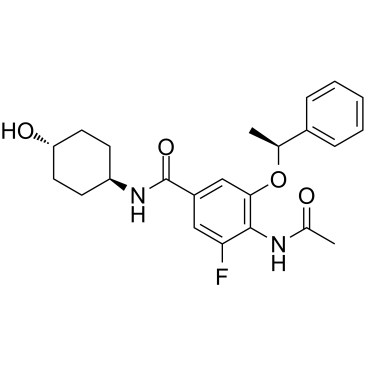| DC33635 |
DODAP
|
DODAP, also known as 1,2-Dioleoyl-3-dimethylammonium-propane, is a cationic lipid. It has been used as a component in liposomes that can be used to encapsulate siRNA, immunostimulatory oligodeoxynucleotides, antisense oligonucleotides, or chemotherapeutic agents for in vitro and in vivo delivery. |
| DC58047 |
DSPE-PEG 2000
|
PEG2000-DSPE is used for creating micelles that are able to carry drugs with low solubility. |
| DC31000 |
LP-01
|
LP-01 is an ionizable cationic amino lipid (pKa = ~6.1). It has been used in the generation of lipid nanoparticles (LNPs). LNPs containing LP-01 and encapsulating both Cas9 mRNA and modified single-guide RNA (sgRNA) for the transport protein transthyretin (Ttr) induce gene editing in liver cells in mice in a dose-dependent manner resulting in reduced serum Ttr levels for at least 12 months. |
| DC66546 |
R-Sirpiglenastat
|
R-Sirpiglenastat is the R- isomer of Sirpiglenastat(DRP-104).Sirpiglenastat (DRP104) is a broad acting glutamine antagonist. Sirpiglenastat has anticancer effects by directly targeting tumor metabolism and simultaneously inducing a potent antitumor immune response. |
| DC60597 |
AZD0780
|
AZD0780 is the first oral small molecule PCSK9 inhibitor for the treatment of hypercholesterolemia. |
| DC66114 |
FAPI-46
|
FAPI46 is a quinoline-based fibroblast activation protein (FAP)-targeted radiotracer. FAPI-46 has higher tumor uptake and prolonged tumor accumulation. FAPI 46 can be used for tumor imaging of a multitude of different cancers. |
| DC60580 |
Endosidin5(ES5)
|
Endosidine 5 (ES5), is one of the most potent small molecules interferes with recycling endosomes through Annexin A6, thereby promoting the release and expression of mRNA into the cytoplasm. The delivered mRNAs is greatly enhanced via inhibition of endocytic recycling in cells and in live mice. NAV2729 (NAV) and endosidin 5 (ES5), resulted in significant enhancement (1.5–2 folds) of LNP-mediated delivery of Fluc mRNAs. Incubation of NAV and ES5 together caused modest further increases in Fluc expression in comparison to the sole application of either compound. |
| DC90056 |
PLX-5622 HCl form (water solubility form)
|
PLX5622 is the HCl salt form of PLX-5622, which has better water solubility.PLX-5622 is a highly selective brain-penetrant CSF1R inhibitor (IC50=0.016 µM; Ki=5.9 nM) allowing for extended and specific microglial elimination, preceding and during pathology development. |
| DC60559 |
PT-179
|
PT-179 is a new orthogonal immunomodulatory drug (IMiD) derivative that binds CRBN but does not induce degradation of off-target proteins. PT-179 potently degrades proteins fused to SD40 at either the N or C terminus. |
| DC65841 |
MC1
|
MC1 is a selective and potent inhibitor for COX-2, and [11C]MC1 detected COX-2 in nonhuman primates after intracerebral injection of an inflammogen. |






















